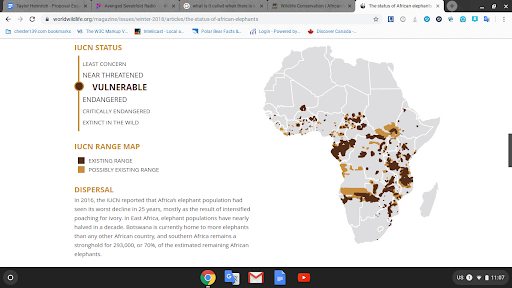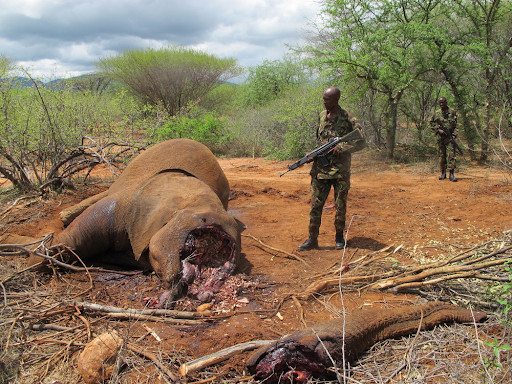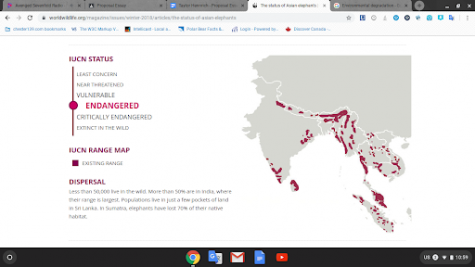The Fall of the Gentle Giants

November 27, 2019
Disclaimer: graphic images are used in this paper
Elephants have been around for millions of years, and over those years their numbers have dwindled. There are two main species of elephants: the African elephant and the Asian elephant. They each separate into 10 representative species of elephants. Elephants have many things in common: habitat loss, emotional damage (PTSD), and poaching. What will it take to stop the decline of the elephants?


The number of elephants has dwindled ever since poaching and cutting down mass amounts of trees has become more popular. Recently, according to the World Wildlife Fund, “While elephant poaching is trending downwards, with significant declines in East Africa, poaching continues to steer the species dangerously nearer to extinction” (“The Status of African Elephants”). The map to the right, provided by the WWF, shows the existing range of African elephants in relation to the possible existing range of elephants in 2018. This is a drastic change compared to what the population was in the 19th century, where numbers were in the millions. The “Future for Elephants” organization created the chart on the right. The chart presents the declining population. In the 1800s, the population was at 27,000,000; now, as of 2016, the population has tanked to 460,000. In 2018, the population decreased by 10,000. Over all of Africa, there are at least 10 range states that protect African elephants. Even though there are ten range states that protect the population, not enough is being done to stop it.

African elephants are not the only ones that suffer. Asian elephant numbers are between 35,000 and 40,000. Asia has a deforestation problem. Companies often “harvest” trees for various things like palm oil, agriculture, illegal logging, paper, and even the little things like dog food. China has only 3.34% of its forest left. Countries are destroying their rainforests and replacing them with palm oil trees. This is bad for all the animals that are living there. Elephants in Asia deal with poaching, but more habitat loss than anything. Asian elephants are often victims of trafficking of live animals, too. Elephants are mistreated in places like circuses, show events that involve elephants, and even tourist attractions. Asian elephants are easier to maintain, being slightly smaller than the African elephant. Asian elephants are also still used for labor. They are particularly used for forestry work, which is people destroying the elephants’ own habitat and making them work to destroy it. “Asian elephants are more endangered than their African cousins. That’s because the biggest threat to their survival isn’t poaching but habitat loss” (Status of Asian Elephants, 2018). Less than 50,000 Asian elephants live in the wild. 50% of the elephants are actually in India instead of its neighbor China, which is the 3rd largest country in the world. Elephants in both Africa and Asia should not be treated this way. Something more can be done than what they are doing now.
The population of people is constantly growing. People need places to live, so they cut down the habitats that the elephants live in. These elephants used to roam all over Asia, but now are restricted to 15% of their original range. Asian elephants located in India also suffer the same problem as the elephants living in Asia. With few reserves to protect the elephants, they struggle to survive. In Asia, there are 21 national parks that help protect elephants. In both Africa and Asia, the parks help protect the elephants from people who poach and habitat loss.
Even though there are reserves for elephants, poaching still continues to happen. Poaching has been a big industry for many years. In the 1800s it was legal to hunt animals with ivory, and it was illegal to sell them. This type of hunt was called “Trophy Hunting.” During the late 20th century, many bans were introduced to stop the illegal selling of ivory. The people of Africa started to realize the danger of the decline of elephants. “In 1989 CITES (Convention on International Trade in Endangered Species) effectively banned the international commercial trade in African elephant ivory by placing the species on Appendix I.” This made elephant populations in the wild somewhat stable. Even with bans placed on ivory trade, it is still a problem. People still poach, people still kill, and for what? Ivory is used as mainly jewelry and herbal medicine that is not even useful to the human body. Why use ivory jewelry when you can use cheap jewelry for 2 or 3 dollars? Is this useless ivory really worth the pain and suffering of an elephant? Elephants, like us, suffer from PTSD. Most likely some members of the herd this bull was in is suffering to this day. The people in this picture are anti-poaching squads that are deployed by Northern Rangeland Trust (NRT). This elephant had died weeks ago from when the poachers shot him. The elephant bull would have weighed six tons or more but lost weight due to animals snacking off of him. His tusks weighed about 20 kilograms or 44 pounds. Martin Fletcher took this picture and wrote a very emotional article about what it was to experience finding something like this. He wrote, “We stared in silence, appalled that such a magnificent creature could be reduced to something so vile. The elephant’s carcass was an apt metaphor for the avarice that killed it. It was contaminating the air and ground around it, just as China’s hunger for ivory is corrupting Africa.” In some parts of Africa, it is legal to shoot poachers on site. This policy is called “shoot-to-kill.” Tanzania was the country that pressured this policy. Poaching in Africa is a big problem, but in another continent, there are somewhat different problems.
In a tropical place over on the other side of the world, there was a coral reef. Due to fishing, almost all the sharks in the area were wiped out. The reef started to die, and the reef was displeasing to look at. There were zero fish, and the reef was grey. The country close to this reef made this place a conservation area for the sharks to repopulate. The sharks finally bounced back in numbers and the reef became beautiful again. This is a solution one country took and it worked. The countries in Africa have been instituting places like the reef, but why are elephants still declining in numbers? The answer is of course poaching. If more countries could accept policies like “shoot-to-kill,” then the rate of elephant numbers declining would go down. Laying stricter laws on the poachers would help, too. World Wildlife Fund is reducing the threat with anti-poaching squads that are patrolling. If the African governments would push more anti-poaching squads with their own military, then the government would help reduce the poaching in numbers. If Africa worked together to make more areas to protect the elephants, then the numbers would be reduced as well.
In Asia, preserving elephants is not as important. There are national parks across Asia, but not as many as there should be. Most of these problems occur through the governments of countries not wanting to protect the animals because of their own economic gain. Working with the governments of Asia would provide a way for more parks to be set up and have the cost of habitat loss to be at least a quarter of the way gone. Growing populations cannot really be stopped without being inhumane about it. Putting more national parks in places like India would make the population of humans grow around the area of the park. Poaching in Asia could be stopped the same way as it is in Africa. Put more anti-poaching squads and policies in place to stop the poaching in Asia.
People in the United States can help, too. There are various organizations that people can donate to. World Wildlife Fund gives many opportunities to donate to protect elephants. People can symbolically adopt an African or Asian elephant for the amount of money people want to donate. Making a donation of money helps with protecting an endangered species’ habitat. WWF also has the option of becoming a member; that money goes to animals and habitats as well. Even the U.S Fish and Wildlife Services offers a place to donate money to the “African Elephant Conservation Fund.” Another organization people can donate to is the African Wildlife Foundation. This organization allows people to donate and fundraise.
Elephants across the world are suffering, each and every one of them. Africa deals with poaching while Asia deals with primarily habitat loss. The actions of each and every country in both those continents are showing, and some are not looking too good. Countries around the world can help by donating to the cause. Coming together will stop the decline of elephants.
Works Cited
Fletcher, Martin. “The War to Save the Elephants / Prospect.” Martin Fletcher, 2014, http://www.martinanthonyfletcher.com/the-war-to-save-the-elephants-prospect
“Ivory Trade and CITES.” Humane Society International, Humane Society, 20 May 2019, https://www.hsi.org/news-media/african_ivory_trade/
“The Status of African Elephants.” WWF, World Wildlife Fund, 2018, https://www.worldwildlife.org/magazine/issues/winter-2018/articles/the-status-of-african-elephants
“The Status of Asian Elephants.” WWF, World Wildlife Fund,
https://www.worldwildlife.org/magazine/issues/winter-2018/articles/the-status-of-asian-elephants
“The Crisis in Africa / Elephant Numbers.” Home, Future for Elephants, https://www.futureforelephants.org/index.php/information/the-crisis-in-africa-elephant-numbers
